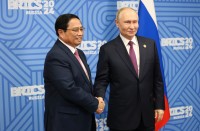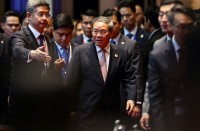
QUEZON CITY, May 13 – Despite the increasing contribution of small and medium enterprises (SMEs), particularly in terms of job generation and contribution to GDP in the Association of Southeast Asian Nations (ASEAN) region, experts argue that they remain one of the region’s untapped resources.
In a recent forum organized by state think tank Philippine Institute for Development Studies (PIDS), Asian Development Bank (ADB), Department of Trade and Industry, Management Association of the Philippines, and Financial Executives of the Philippines, experts concurred that a lot can still be done to unleash the potential of SMEs.
Currently, SMEs comprise the largest number of firms in the ASEAN region. They generate the majority of jobs and substantially contribute to ASEAN’s GDP.
ADB’s Vice President for Knowledge Management and Sustainable Development Bambang Susanto stressed in his keynote address the importance of opening access and opportunities for micro and small and medium enterprises.
To help SMEs play their role in the domestic, regional, and global production networks, Susanto suggested that the ASEAN Economic Community (AEC) must build the physical connectivity of SMEs, raise their labor productivity and skills to standards of global value chains, and improve their access to finance.
Meanwhile, PIDS Senior Research Fellow Erlinda Medalla and ADB Advisor Ganeshan Wignaraja discussed how to improve SMEs’ access to market and investment opportunities in the AEC.
“SMEs play a role not just as a vehicle for poverty reduction but also as an engine of growth,” said Medalla. She emphasized the sector’s employment and value added contributions to the Philippine, which peaked at 65 percent and 35 percent, respectively. Across Southeast Asia, Wignaraja noted that SME employment makes up 74 percent of all jobs, and contributes 41 percent of the GDP of ASEAN economies.
Yet, Wignaraja lamented that these contributions are not yet reflected in international trade. Wignaraja observed that high-performing SMEs make up only 21 percent of direct exports across ASEAN economies.
Many factors obstruct the growth of SMEs, but one of the oft-cited problems is the lack of access to finance and credit. Wignaraja explained that the current banking and credit structure does not know how to deal with SMEs. Bank requirements on collateral and business and finance plans are strict. Unable to comply and lacking financial literacy, SMEs are often forced to rely on informal resources.
SMEs simply do not have access to the capital they need to expand or participate in larger business and trading activities. According to Wignaraja, total credit gap, or the difference between formal credit provided to SMEs and estimated SME financing needs in ASEAN, amounts to as much as USD 52.8 billion.
Wignaraja also pointed out that as China begins to slow down and move out of labor-intensive industries, firms in countries like the Philippines, Malaysia, and Thailand will have more business opportunities as suppliers of a range of products.
“International trade itself has fundamentally changed in the 21st century and is no longer about direct exports. Instead, trade increasingly means global supply chains where different production on stages are located across geographical space and linked by trade in intermediate inputs and final goods,” Wignaraja pointed out.
Meanwhile, Medalla said the Philippines does not have much of a choice whether or not it wants to partake in this new landscape. In an increasingly economically integrated ASEAN, she said, “SMEs have to work within a globalized setting.”
However, she added that “not all SMEs can export, and they do not need to. The goal should be for them to have all the opportunities to participate and engage in business in order to help them grow and contribute in sustaining the expansion of the economy.”
To do this, Medalla enumerated a number of factors that the Philippines has to address to encourage SMEs to participate in value chains. She reiterated Wignaraja’s point about addressing the lack of access to finance and credit, but added that enabling the environment for SME firms to develop competitiveness and connectivity must be prioritized as well.
While Wignaraja believes that much of the work must be done by business and private sector in boosting labor productivity, improving the investment climate, raising infrastructure spending, improving information and communication technology infrastructure, and increasing financial access for SMEs, both experts are in agreement that the government also has a critical role to play in SMEs’ success.
“Government’s role is to enable and facilitate the linkages and access to markets, finance, and technology, and to remove various barriers to entry and exit. The role of the new Competition Law will be very important,” Medalla said.
Policymakers should also concentrate on enhancing strategic opportunities. Medalla said the kind of policies needed depends on which SME sector policymakers intend to help. She recommended policies that would raise SMEs’ capability to comply with AEC standards, such as developing the halal industry, improving trade facilitation, and identifying standards to enable them to access a “duty-free” ASEAN market.
She also recommended helping each sector gain competitive advantage through industry clustering, sharing services facilities, and developing industry roadmaps.
“The opportunities are there in the supply chains,” said Wignaraja. The business sector has to adopt smart strategies to capture opportunities to participate in the production networks, and policymakers must create the enabling business environment for SMEs to thrive. (PIDS)







